How to Fix Unexpected Store Exception in Windows 10/11
Have you ever encountered the Blue Screen of Death (BSOD) issue with an Unexpected Store Exception error code when working on an important project or playing an epic game? This Unexpected exception error can be a frustrating obstacle since it will cause a system crash and stop all processes on your computer. Fortunately, Qiling will offer ten reliable solutions to help you solve Unexpected exception error and restore the device's health.
How to Fix Unexpected Store Exception Error in Windows 10/11
- Way 1. Apply Boot Repair
- Way 2. Run System File Checker
- Way 3. Check Hard Drive Health
- Way 4. Adjust the BIOS Configuration
- Way 5. Update the Display Driver
- Way 6. Disable the Fast Startup and Sleep Features
- Way 7. Temporarily Disable Your Anti-Virus Software
- Way 8. Update Your Windows 10/11
- Way 9. Use the High-Performance Power Plan
- Way 10. Disable File History & Clear Temporary File
Suppose your computer turns to a blue screen and shows the message: Your PC ran into a problem and needed to restart. We're just collecting some error info, and then we'll restart for you. You may come up with the Unexpected Store Exception error. No need to worry. This part will discuss ten different ways and detailed steps to help users address the "Unexpected Store Exception" blue screen error.
Common Unexpected_Store_Exception Errors:
Many problems are classified as BSoD errors and fixed with similar techniques we will cover in the article.
- Unexpected Store Exception No bootable device: It indicates a hardware problem where the bootable device is not firmly inserted into the slot.
- Unexpected Store Exception critical process died: This error appears when a system file becomes corrupted, impeding the boot process.
- Unexpected Store Exception SSD and hard drive: This problem is caused by defective or improperly installed hardware.
- Unexpected Store Exception Blue Screen Error: Driver corruption is the main cause of this problem; therefore, updating or reinstalling drivers is necessary.
- Unexpected Store Exception while gaming: This error is caused by a driver problem that causes the system to restart repeatedly while gaming.
Way 1. Apply Boot Repair
Qiling Disk Master Professional is a powerful tool that empowers novices to handle various Windows startup issues such as system crashes, boot freezes, and color screen of death errors. With the help of its "Boot Repair," Windows users can repair Unexpected Store Exception error effortlessly. Moreover, it's available in most versions of Windows versions.
This process will create a bootable media and fix BSoD errors in the WinPE environment with a simple and user-friendly process.
Here are easy steps:
Step 1. Start Qiling Disk Master after connecting the external drive/USB to your computer, go to "Tools" and click "Create bootable media".

Step 2. Select an available USB Drive or CD/DVD and click "Proceed". You can also burn the Windows ISO file to the storage media.

Step 3. Connect the created bootable drive to the new computer and reboot the computer by pressing and holding F2/Del to enter the BIOS. Then, set the WinPE bootable drive as the boot disk and press F10 to exit.
Step 4. Boot the computer again and enter the WinPE interface. Then, open Qiling Disk Master and click "Fix Boot" under the "Tools" option.
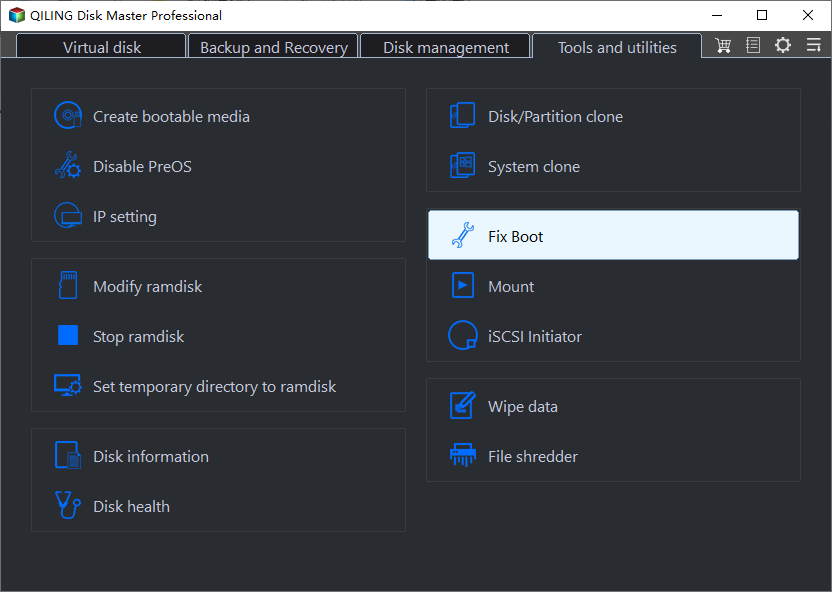
Step 5: Select the system you want to repair and click "Proceed".
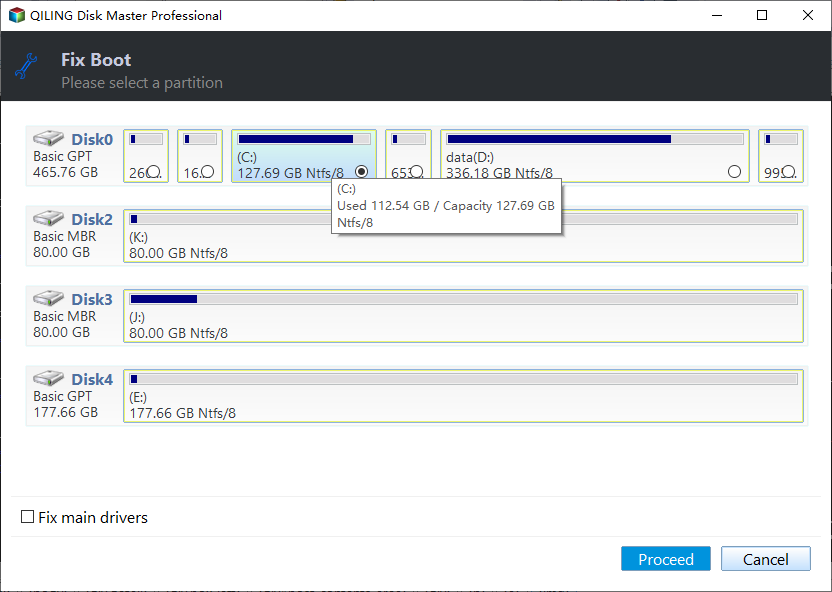
Step 6. Wait a moment, and you will receive an alert that the system has been successfully repaired. Click "OK" to complete the boot repair process.
You can also apply Qiling Disk Master when you experience the following scenarios:
Way 2. Run System File Checker
Corrupted system files can lead to an Unexpected Store Exception blue screen error. You have two advanced options to efficiently diagnose and repair corrupted or missing system files.
Option 1. Qiling Disk Master
Qiling Disk Master provides a one-click "Check File System" tool to help beginners check and repair system files without wasting time.
Step 1. Open Qiling Disk Master on your computer. Then, locate the disk, right-click the partition you want to check, and choose "Advanced" > "Check File System".
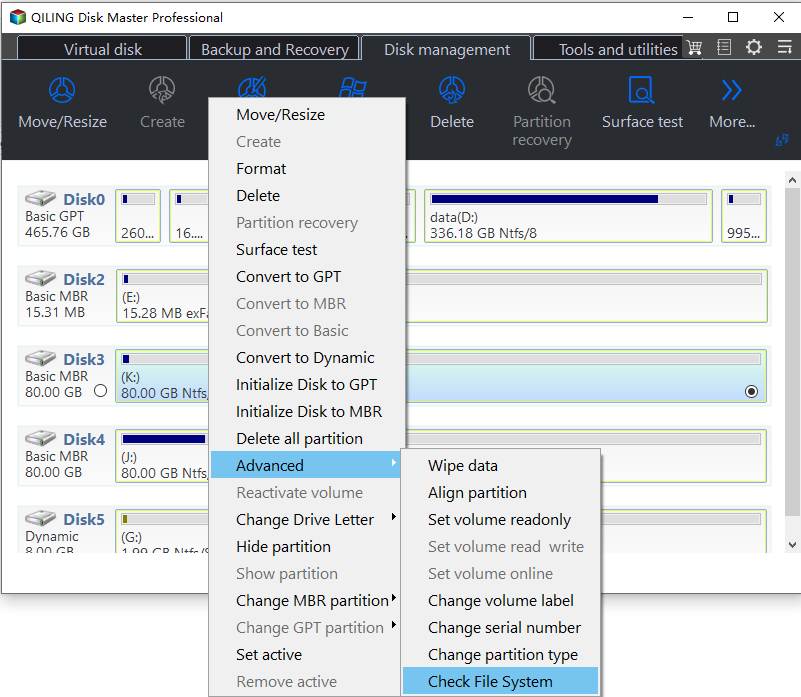
Step 2. In the Check File System window, keep the "Fix the error on the disk" option selected and click "Proceed".

Step 3. The software will begin checking your partition file system on your disk.
Option 2. Run SFC scannow Command
Windows also offers a built-in tool that can check system files and fix when there are problems with them. Follow this tutorial to run the system file checker scan:
Step 1. Click on the Start button and search for Windows Powershell. Right-click it and select Run as Administrator.
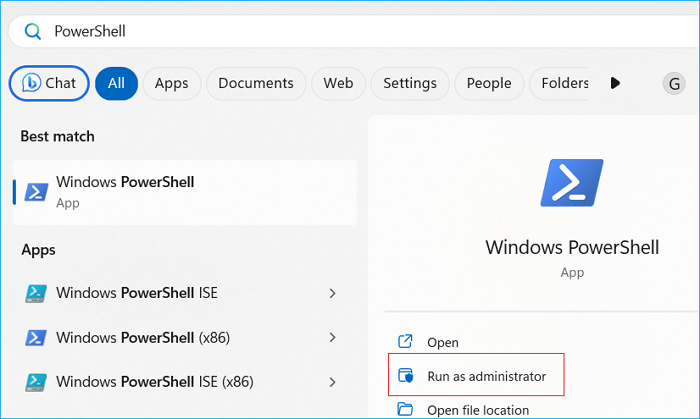
Step 2. A blue window will open, type sfc/scannow and tap Enter key to begin.
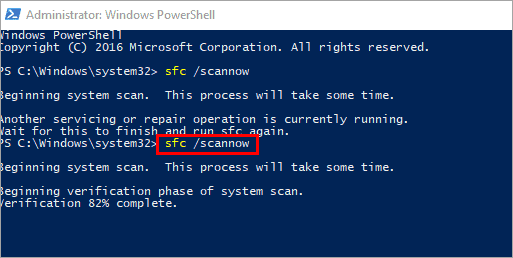
Step 3. After the process, you can exit this window by typing quit and hitting Enter.
This system file check program may take a long time, so don't close the PowerShell window or shut down your computer.
Way 3. Run Check Disk Utility
Another main reason for the Unexpected Store Exception issue is bad sector or file system corruption on your hard disk. Hence, you can run the CHKDSK utility to identify and fix the disk issues:
Step 1. Type cmd in the Windows 10/11 search dialog, and run the Command Prompt utility as an administrator.
Step 2. In the Command Prompt window, type the command chkdsk C: /f /r /x and execute it by tapping "Enter."
Note: Replace the C: with the target disk name that you want to run the disk check.
Way 4. Check the BIOS Configuration
Your BIOS setup may have been compromised if you recently updated your machine. Due to improper hard disk configuration, your system may crash and display the Windows halt code Unexpected Store Exception issue. Thus, you need to check and change the incorrect BIOS configuration, which requires some technical knowledge. It's recommended that users read and follow the motherboard manual to make the changes.

🔍Suggested Reading: 6 Ways to Fix Blue Screen Error APC Index Mismatch in Windows 10
Way 5. Update the Display Driver
An outdated display driver or malfunction in it can run into the Unexpected Store Exception error. The simplest way is to update your display driver. Refer to the comprehensive guide below:
Step 1. Use the "Windows + X" shortcut keys to select "Device Manager".

Step 2. Find and right-click "Display driver" and choose "Update driver" from the menu.
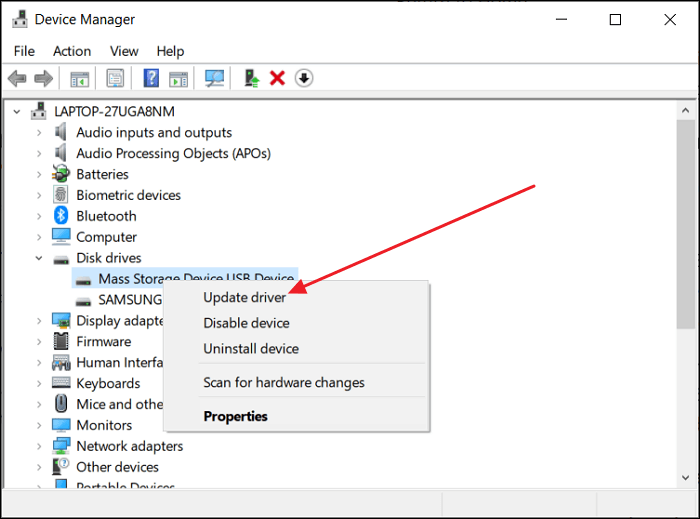
Step 3. Select "Search automatically for updated driver software in the next window."

Step 4. Wait patiently till the process is complete.
Way 6. Disable the Fast Startup Features
While Fast Startup is designed to shorten the boot times, some Windows users have reported that it may lead to device errors like Unexpected Store Exception. You can follow the steps to disable the Fast Startup easily:
Step 1. Click the "Start" button, and choose "Settings" > "System" > "Power & Sleep". A new window will open, then select "Additional power settings."
Step 2. Select "Choose the power buttons" / "Choose what the power buttons do."
Step 3. Select the "Change settings that are currently unavailable" option. It may require entering administrator credentials.
Step 4. Uncheck the "Turn on fast startup (recommended)" box and click "Save changes."

Then, restart your computer to see if the BSOD error is resolved.
Way 7. Temporarily Disable Your Anti-Virus Software
Antivirus software will interfere with your internet connection or prevent some programs and services from operating correctly, which might lead to problems with your computer. By temporarily stopping your antivirus program, you can see if it's the source of the Unexpected Store Exception problem.
- Warning
- Disable or uninstall your anti-virus application will expose your device to risk and damage. Make a backup before using this way.
For Windows Built-in Anti-virus Program:
Step 1. Open "Windows Settings" and select "Update & Security."
Step 2. Tap "Windows Security" and click "Virus & Threat Protection."
Step 3. Choose "Virus & Threat Protection Settings" and switch the slider to turn off Real-time protection.
For Third-party Anti-virus Software:
Step 1. Hold the "Windows + X" keys to open Task Manager in the menu.
Step 2. Expand details by clicking on the "Mode details" when Task Manager is shown as compact mode.
Step 3. Go to the "Start-up" tab at the top of the window.
Step 4. Locate your antivirus software from the App list and click on it.
Step 5. Then, select the Disable option in the bottom-right of the window.
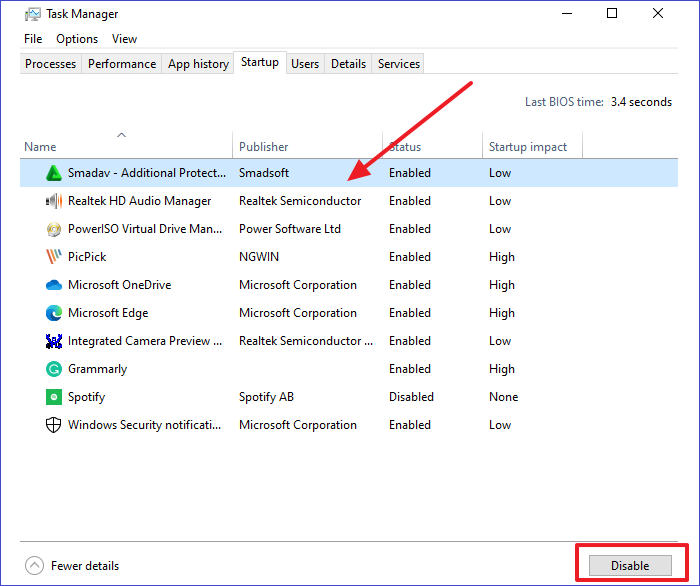
Reboot your computer and see if the Windows 10 Unexpected Store Exception error is solved.
Way 8. Update Your Windows 10/11
Sometimes, corrupted files can cause the system to encounter stop code unexpected store exception errors. Additionally, the software with advanced versions can't be compatible with outdated systems. As a result, you can turn to updating your Windows 10 or 11 system to the latest version:
- Click the Start icon and navigate to Settings. Alternatively, try the "Windows + I" shortcut keys to access this utility quickly.
- Select "Update & Security" > "Windows Update."
- Choose the "Check for updates" button.
- When a new update is found, hit the Install button and wait for the system to apply the update.
If you recently updated your Windows 10 system and encountered an Unexpected Store Exception error, you can also restore Windows to its previous version.
Way 9. Use the High-Performance Power Plan
Your computer's performance will automatically decrease if you are on "Balanced" or any other power plan. This can also result in the Windows halt code unexpected store exception issue. Hence, you need to switch to the "High-Performance power plan."
- Click the Start button > "Settings" > "System" > "Power & Sleep" > "Additional power settings."
- Tick the "High Performance" option and then go to "Change plan settings."
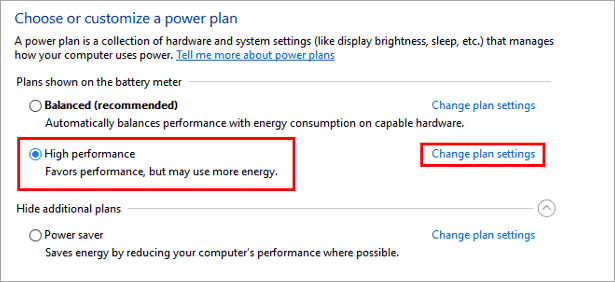
- Find the "Put the computer to sleep" tab and choose "Never" >"Save changes."
All ten fixes can assist users in repairing the Unexpected Store Exception issue in Windows 10. Thus, share this page with people who seek for help:
Way 10. Disable File History & Clear Temporary File
File History is a Windows utility that enables users to backup and repair corrupted files. However, it's reported that this feature can be a reason for the Unexpected Store Exception blue screen error. Here is how to do it:
Disable File History:
- Search and open Windows Settings, and click on "Update & security"> "Backup."
- Uncheck the "Automatically back up my files" option.
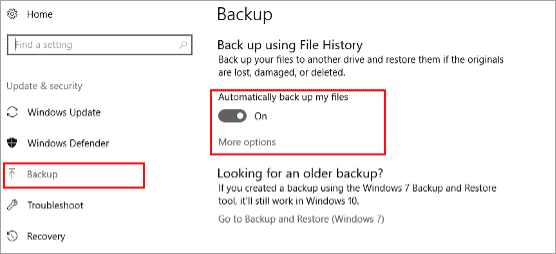
Delete Temporary Files:
- Press "Windows + I" to quick access Windows Settings, click "System" > " Storage."
- Choose "This PC (C:)" to analyze.
- Choose "Temporary files".
- Check the box of content you want to delete and select the "Remove files" button.

⭐Ask For Help
If you need further explanation or assistance on any method or step, our dedicated support staff is ready to provide tailored guidance:
Qiling experts are available to provide you with 1-on-1 manual services (24*7) and help fix Windows boot error, BSOD or computer boot loop issues. Our experts will offer you FREE evaluation services and efficiently diagnose and resolve system boot failure, Windows stop codes and OS lagging issues using their decades of experiences.
- 1. Fix BSOD - blue/black screen of death error due to Windows update or other reasons.
- 2. Get rid of Windows boot error such as no bootable device found, or BCD file corruption.
- 3. Serve to fix 0X000_error codes on Windows system or OS boot loop issues.
Why Windows Unexpected Store Exception Error Arise
To avoid the Windows Unexpected Store Exception error in the future, we should explore what causes it. This BSoD error can arise due to a variety of reasons, including:
- Corrupted system files: If important system files are corrupted or damaged, it can lead to the Unexpected Store Exception error.
- Incompatible hardware or drivers: This error can be triggered if compatibility issues exist with certain hardware components or drivers.
- Memory issues: Problems with the computer's memory, such as faulty RAM modules, can cause the Unexpected Store Exception error.
- Bad sectors on the hard drive: Issues with the hard drive, such as bad sectors or filesystem corruption, can result in this error.
- Software conflicts: Conflicts between different software programs or conflicting system settings can also lead to the Unexpected Store Exception error.
- Windows Update Conflicts: If you apply a Windows update and your PC gets a blue screen, you can restore the Windows to the previous version.
- Malware or virus infections: Malicious software can disrupt system operations and cause various errors, including the Unexpected Store Exception error.
Conclusion
In conclusion, this article covers multiple solid ways to repair BSoD issues with Unexpected Store Exception errors. Besides we also explore what may cause this error and explain it in detail. This post shows that Qiling Disk Master is a versatile and professional tool for repairing most Windows unbootable or color screen errors. Apply its "Boot Repair," "Check File System," and "Check disk health" functions to fix your BSoD errors:
FAQs About Unexpected Store Exception Error
Follow us and find more valuable information about Unexpected Store Exception BSoD Errors in this FAQ part:
1. What causes the Unexpected Exception error in Windows?
Unexpected Exception errors can arise from a variety of causes, such as incorrect user input, programming errors, device malfunctions, lost network connections, memory conflicts with other applications, programs trying to divide by zero, or users trying to access files that aren't accessible.
2. How do you fix a blue screen of death?
You can fix BSoD by using these ways: restore the Windows, check the system file, and apply Boot Repair via Qiling Disk Master. The last solution is the easiest and quickest for computer users. Learn step-by-step tutorials for each method on the following page:
💡Further Reading: How to Fix BSOD: Blue Screen of Death Error
3. How do you factory reset a Windows PC?
To factory reset your PC, Click Start > Settings > Update & Security > Recovery > Reset this PC > Get Started. Then, choose Keep my files Cloud or Local, adjust your settings, and set Restore preinstalled apps.
Related Articles
- How Can I Check USB Health and Fix USB Errors on Windows 11 and Mac
- How to Resize USB Flash Drive Partition with Magic Partition Software
- Samsung Format Utility Download Free [With Guide] 🚩